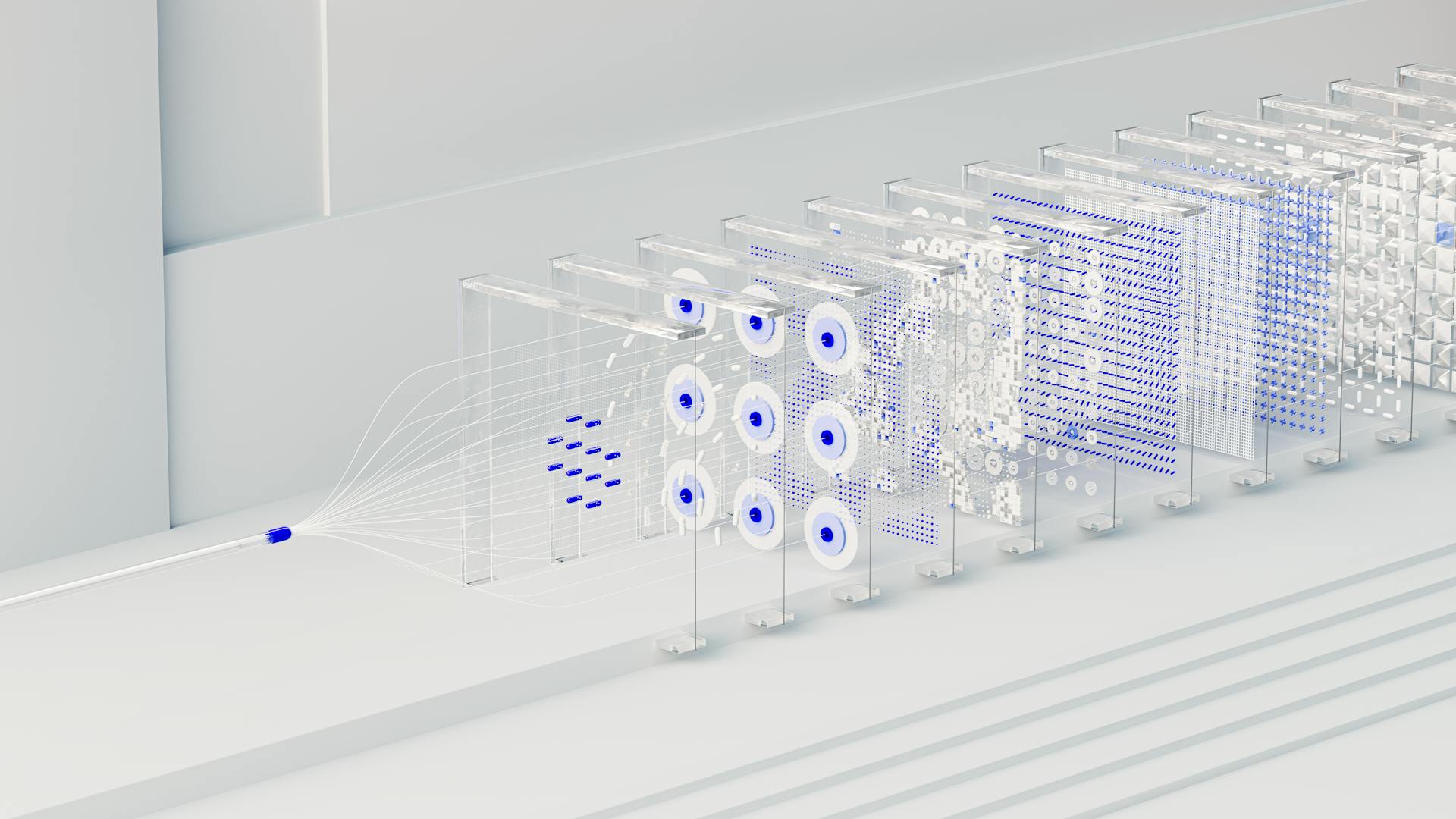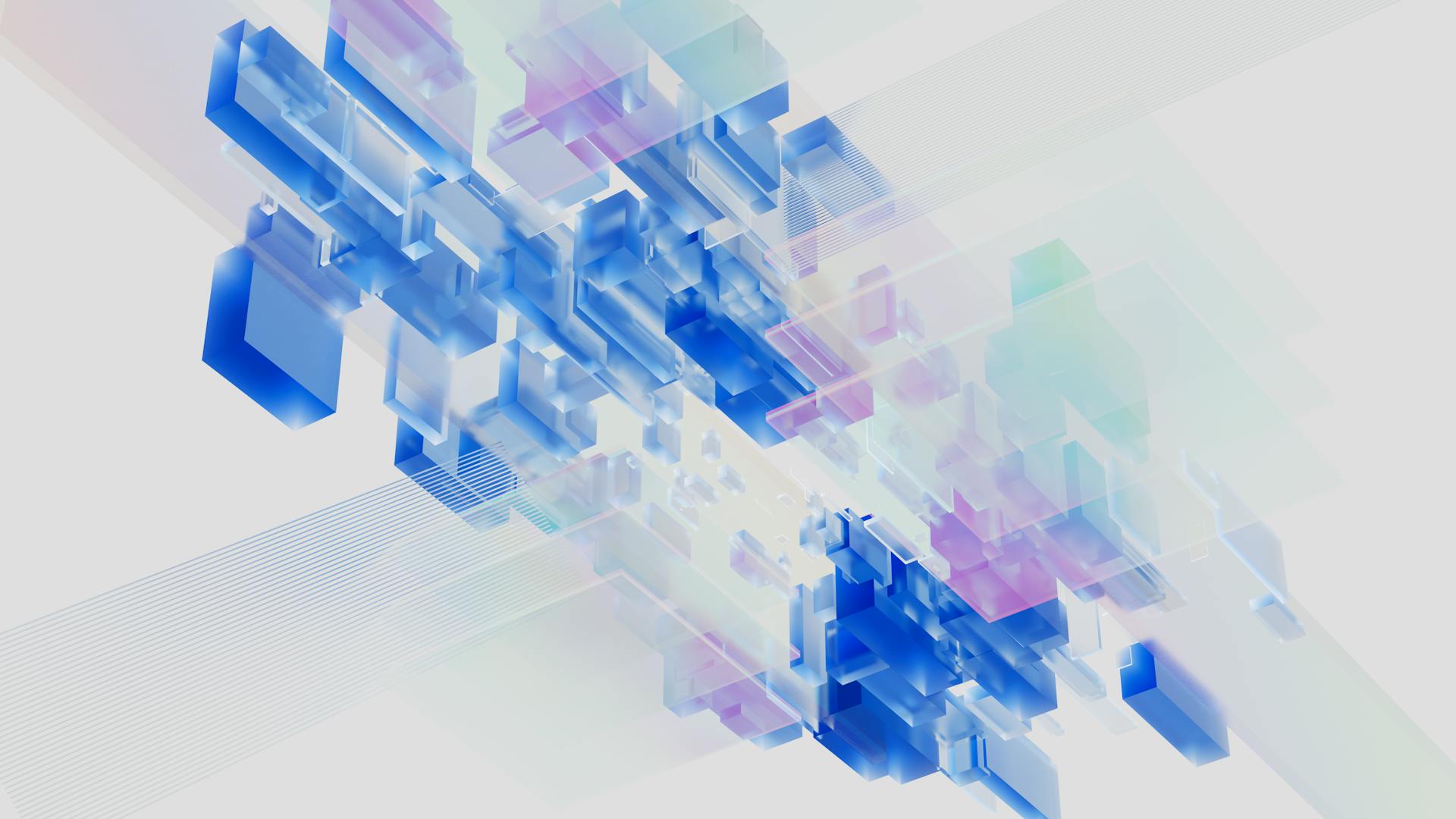
Deep learning algorithms have revolutionized the field of artificial intelligence, enabling machines to learn and improve on their own. They're a type of machine learning that uses neural networks to analyze and interpret complex data.
One of the key techniques used in deep learning is convolutional neural networks (CNNs), which are particularly effective for image recognition tasks. CNNs can identify patterns and features in images that humans often overlook.
Deep learning has numerous applications, including image classification, speech recognition, and natural language processing. These techniques have been used to develop virtual assistants like Siri and Alexa, which can understand and respond to voice commands.
The power of deep learning lies in its ability to learn from large datasets, allowing it to improve its performance over time. This is especially evident in applications like image classification, where the algorithm can learn to recognize objects and scenes with high accuracy.
Recommended read: Ai Facial Recognition Software
Deep Learning Basics
Deep Learning is a large area that, at first, might be overwhelming. It is critical to select the correct approach for the work at hand because the improper model might degrade performance or make solving your problem impossible.
Artificial Neural Networks are the foundation of deep learning techniques, named after the fact that they mirror the way the human brain works.
Artificial Neural Networks are made up of linked neuron nodes, which are the building blocks of deep learning algorithms.
You might like: Neural Network vs Generative Ai
What is Deep Learning?
Deep Learning is a large and complex area that can be overwhelming at first, but it's essential to understand the basics to get started.
Deep Learning is based on Artificial Neural Networks, which are essentially linked nodes that mimic the way the human brain works.
Artificial Neural Networks are the umbrella term for all deep learning techniques.
Deep Learning is all about finding the right approach for your specific problem, because using the wrong model can degrade performance or even make solving your problem impossible.
Gradient Descent Basics
Gradient Descent is an algorithm designed to minimize a function by iteratively moving towards the minimum value of the function. It's like a hiker trying to find the lowest point in a valley shrouded in fog.
The hiker starts at a random location and can only feel the slope of the ground beneath their feet. To reach the valley's lowest point, the hiker takes steps in the direction of the steepest descent.
You might like: On the Inductive Bias of Gradient Descent in Deep Learning
The objective of Gradient Descent is to find a function's parameters (weights) that minimize the cost function. In the case of a deep learning model, the cost function is the average of the loss for all training samples as given by the loss function.
The update rule for each parameter w can be mathematically represented as w = w - α * ΔwJ(w), where w represents the model's parameters (weights) and α is the learning rate.
The learning rate is a crucial hyperparameter that needs to be chosen carefully. If it's too small, the algorithm will converge very slowly. If it's too large, the algorithm might overshoot the minimum and fail to converge.
A good grasp of the technical and mathematical details of Gradient Descent is essential, as all deep learning model optimization algorithms widely used today are based on it.
Here's a summary of the key components of Gradient Descent:
- Objective: Minimize the cost function by adjusting the model's parameters (weights)
- Update rule: w = w - α * ΔwJ(w)
- Learning rate: A crucial hyperparameter that needs to be chosen carefully
Sequence Modeling
Sequence modeling is a crucial part of Natural Language Processing, used in applications like Machine Translation, Speech Recognition, and Sentiment Classification.
Sequence models can process a sequence of inputs or events, such as a document of words. They're great for tasks that involve understanding the order of words or events.
To translate a sentence from English to French, you need a Sequence to Sequence model, also known as a seq2seq model. This type of model includes an encoder and a decoder.
The encoder takes the input sequence, like a sentence in English, and produces an output, a representation of the input in a latent space. The decoder then uses this representation to generate the new sequence, like a sentence in French.
Recurrent Neural Networks, specifically LSTMs, are commonly used as encoders and decoders because they're good at capturing long-term dependencies. However, Transformers are also used and tend to be faster and easier to parallelize.
Transformers are a type of sequence model that use attention mechanisms to focus on specific parts of the input. They're great for handling ordered sequences of data, like natural language.
BERT and GPT-2 are two prominent pre-trained natural language systems, used in a variety of NLP tasks, and they're both based on Transformers.
A fresh viewpoint: Energy Based Model
Word Embeddings
Word Embeddings are a way to represent words as numeric vectors, capturing their semantic and syntactic similarity. This allows neural networks to learn from text data.
Word2Vec is the most popular technique for learning word embeddings. It uses a simple neural network with two layers to predict a word based on its context or surrounding words. In the case of CBOW, the inputs are the adjacent words and the output is the desired word. In the case of Skip-Gram, it's the other way around.
Glove extends the idea of Word2Vec by combining it with matrix factorization techniques. This union gives us the best of both worlds, capturing both local and global text statistics.
FastText uses a different approach by representing words as character-level vectors. This is a unique way to encode words, but it's not as widely used as Word2Vec or Glove.
Contextual Word Embeddings, like ELMo, replace Word2Vec with Recurrent Neural Networks. These networks can capture long-term dependencies between words, making them a powerful tool for natural language processing.
The most famous version of Contextual Word Embeddings is ELMo, which consists of a two-layer bi-directional LSTM network. This architecture allows ELMo to weigh the most related words and forget the unimportant ones.
Here's a quick summary of the different word embedding techniques:
Autoencoders
Autoencoders are mostly used as an unsupervised algorithm and their main use-case is dimensionality reduction and compression.
They work by trying to make the output equal to the input, effectively reconstructing the data.
Autoencoders consist of an encoder and a decoder, where the encoder receives the input and encodes it in a latent space of a lower dimension.
The decoder takes that vector and decodes it back to the original input, allowing us to extract a representation of the input with fewer dimensions.
This idea can be used to reproduce the same but a bit different or even better data, such as for training data augmentation or data denoising.
For your interest: Ai and Ml in Data Analytics
Neural Network Architectures
Neural networks are made up of layers, with the input layer receiving data and the output layer making a prediction or judgment. Each layer is composed of neurons, which are connected to neurons in neighboring layers.
A layer structure exists in neural networks, with an input layer, a hidden layer or layers that make a judgment or prediction, and an output layer. The number of layers and neurons in a model can be complex, with thousands of neurons in some cases. Fortunately, the network can learn the optimal parameters for each neuron by analyzing the data.
The architecture of neural networks is key to their success, with different types of layers serving specific purposes. For example, convolutional layers are used for image recognition, while recurrent layers are used for sequential data. Some common types of layers include Keras Core Layers, Convolutional Layers, Pooling Layers, and Recurrent Layers.
Recommended read: Ai Training Data Center
The Architecture
Neural Networks are made up of layers, with each layer consisting of neurons that receive signals, multiply them by weights, sum them up, and apply a non-linear function.
The layers are stacked next to each other and organized in a specific structure, with an input layer that receives input, a layer that makes a judgment or prediction about the input, and an unlimited number of layers in between.
A deep neural network is one that contains several levels of layers, and the phrase "Deep Learning" refers to the use of these deep neural networks as the foundation of this area.
The architecture of a neural network can be complex, with thousands of neurons, but fortunately, the network can learn from the data it is given, discovering the ranges of its variables by itself.
Feedforward Neural Networks (FNN) are usually fully connected, with every neuron in a layer connected to all the other neurons in the next layers, and they are exceptionally well-suited to tasks like classification and regression.
Here are some common types of layers found in neural networks:
- Keras Core Layers
- Convolutional Layer
- Pooling Layers
- Locally-Connected layers
- Recurrent Layers
- Embedding Layers
- Keras Merge Layers
Each layer is made up of neurons, and neurons within specific layers are linked to neurons in neighboring layers, allowing the network to learn and make predictions about the input data.
Recurrent Neural Networks
Recurrent Neural Networks are perfect for time-related data and they're used in time series forecasting. They use some form of feedback, where they return the output back to the input, creating a loop from the output to the input to pass information back to the network.
These networks are capable of remembering past data and using that information in its prediction. This is especially useful for tasks that require understanding sequences or patterns over time.
Recurrent Neural Networks have been modified into more complex structures like GRU units and LSTM Units. LSTM Units have been used extensively in natural language processing in tasks such as language translation, speech generation, and text to speech synthesis.
Related reading: Ai Time Magazine
Restricted Boltzmann Machines
Restricted Boltzmann Machines are stochastic neural networks with generative capabilities, able to learn a probability distribution over their inputs.
They consist of only input and hidden layers, with no outputs, which sets them apart from other networks.
In the forward pass, they take the input and produce a representation of it.
In the backward pass, they reconstruct the original input from the representation, similar to autoencoders but in a single network.
Multiple RBMs can be stacked to form a Deep Belief Network, which looks like a Fully Connected layer but is trained differently.
DBNs and RBMs have largely been abandoned by the scientific community in favor of Variational Autoencoders and GANs.
Graph
Graph data is often unstructured and organized in a format that's not a great fit for Deep Learning in general.
Graph Neural Networks are designed to model Graph data, identifying relationships between nodes in a graph and producing a numeric representation of it.
Unstructured data can be found in real-world applications like social networks and chemical compounds.
Graph Neural Networks can be used in various machine learning tasks like clustering and classification after producing a numeric representation of the graph data.
A fresh viewpoint: Data Labeling Companies
Library
The Library is a crucial component of a deep learning algorithm, providing access to a vast repository of pre-trained models and fine-tuned weights. This can save developers a significant amount of time and computational resources.
A well-maintained Library can be a game-changer for researchers and developers, allowing them to build upon existing knowledge and expertise. By leveraging the Library, they can accelerate their projects and focus on more complex tasks.
The Library contains pre-trained models for various tasks, such as image recognition, natural language processing, and speech recognition. These models have already been trained on large datasets, making them a great starting point for new projects.
Developers can use the pre-trained models as a foundation and fine-tune them for their specific needs, rather than starting from scratch. This approach can lead to faster development times and more accurate results.
The Library is often updated with new models and weights, ensuring that developers have access to the latest advancements in the field. This continuous improvement enables them to stay ahead of the curve and tackle complex problems with confidence.
Intriguing read: Stable Diffusion Fine Tune
Optimization Techniques
Optimization techniques are a crucial aspect of deep learning algorithms, and understanding them can make a significant difference in the performance of your models.
One of the most fundamental optimization algorithms is Gradient Descent, which aims to find the minimum value of a function by iteratively moving towards it. This is achieved by adjusting the model's parameters (weights) based on the gradient of the cost function.
Gradient Descent can get stuck in local minima or saddle points, especially in non-convex optimization problems common in deep learning. Choosing the right learning rate is also crucial, as it can affect the convergence speed and stability of the algorithm.
Stochastic Gradient Descent (SGD) is a variant of Gradient Descent that introduces randomness into the optimization process, potentially allowing the algorithm to escape local minima. However, it can also lead to a slower convergence rate.
Mini-batch Gradient Descent strikes a balance between the thoroughness of Gradient Descent and the unpredictability of SGD. It uses a subset of the training data to compute gradients and update parameters, making it a popular choice for deep learning models.
RMSprop is an adaptive learning rate optimization algorithm that addresses the diminishing learning rate issue encountered by AdaGrad. It modulates the learning rate based on a moving average of the squared gradients, ensuring efficient and stable convergence.
AdaDelta is an extension of AdaGrad that seeks to reduce its aggressively decreasing learning rate. It dynamically adjusts the learning rate based on a window of recent gradients, making it more robust and adaptive.
Adam (Adaptive Moment Estimation) combines the best properties of AdaGrad and RMSprop, providing an optimization algorithm that can handle sparse gradients on noisy problems. It maintains estimates of the first and second moments of the gradients, allowing for an adaptive learning rate mechanism.
Here are some popular optimization algorithms used in deep learning, along with their pros and cons:
Deep Learning Applications
Deep learning algorithms have numerous practical applications in various fields. Self-driving cars rely on deep learning to process visual data from cameras and sensors, enabling them to navigate roads safely.
Deep learning is also used in speech recognition systems, allowing users to interact with devices using voice commands. For example, virtual assistants like Siri and Alexa utilize deep learning to understand and respond to voice inputs.
Image recognition is another key application of deep learning, with systems able to identify objects, faces, and scenes with high accuracy. This technology has numerous uses, from security surveillance to medical imaging analysis.
For more insights, see: Ai Is the Theory and Development of Computer Systems
Natural Language Processing (NLP)
Natural Language Processing (NLP) is a key application of deep learning that enables computers to understand and generate human language. This involves tasks such as language translation, sentiment analysis, and text summarization.
NLP can be used to analyze customer reviews and feedback, helping businesses identify areas for improvement. For example, a company might use NLP to analyze customer complaints and identify common issues.
Deep learning models can be trained on large datasets of text to learn patterns and relationships between words. This can help improve the accuracy of language translation and sentiment analysis.
NLP can also be used to generate text, such as chatbot responses or product descriptions. This can be done using techniques such as language modeling or sequence-to-sequence learning.
The accuracy of NLP models can be measured using metrics such as precision, recall, and F1 score. These metrics can help developers evaluate the performance of their NLP models and make improvements.
Take a look at this: Towards Deep Learning Models Resistant to Adversarial Attacks
Examples
Deep learning applications are all around us, and they're making our lives easier and more convenient. For instance, virtual assistants like Siri, Google Assistant, and Alexa are powered by deep learning algorithms that can understand and respond to natural language.
Self-driving cars use computer vision to detect and respond to their surroundings, thanks to deep learning models that can identify patterns in images and videos.
The healthcare industry is also benefiting from deep learning, where algorithms can analyze medical images to detect diseases such as cancer.
Google's AlphaGo program used deep learning to defeat a world champion in Go, a game that requires a deep understanding of strategy and patterns.
Deep learning is also being used in finance to analyze stock market trends and make predictions about future market movements.
A different take: Ai and Ml Images
Localization and Detection
Localization and Detection is a crucial aspect of Computer Vision, allowing us to locate objects in an image and classify them. It's a fundamental task that has been tackled by models like R-CNN, which takes advantage of regions proposals and Convolutional Neural Networks.
R-CNN and its predecessors, Fast R-CNN and Faster R-CNN, propose regions of interest in the form of fixed-sized boxes, which might contain objects. These boxes are then classified and corrected via a CNN, such as AlexNet.
Single-shot detectors like YOLO (You Only Look Once) ditch the idea of region proposals and use a set of predefined boxes instead. YOLOv2, YOLOv3, and YOLO900 have improved upon the original idea, both in terms of speed and accuracy.
YOLO predicts a number of bounding boxes with confidence scores, detecting one object centered in each box and classifying the object into a category. We keep only the bounding boxes with high scores.
The YOLO architecture is available on GitHub, specifically in the darknet-pjreddie repository.
Recommended read: Learn to Code in R
Specialized Deep Learning
Deep learning algorithms can be categorized into several specialized areas, each with its own strengths and weaknesses.
Convolutional Neural Networks (CNNs) are particularly effective for image recognition tasks, achieving high accuracy rates on datasets like ImageNet.
Recurrent Neural Networks (RNNs) are well-suited for sequential data, such as speech or text, due to their ability to learn from temporal relationships.
Long Short-Term Memory (LSTM) networks are a type of RNN that excel at handling long-term dependencies in data.
Generative Adversarial Networks (GANs) are designed to generate new, synthetic data that resembles existing data, often used in applications like image or music generation.
Model Optimization
Model optimization is a crucial step in deep learning, where the connection strength between neurons and their activations are parametrized by weights and biases. These parameters are iteratively adjusted during training to minimize the discrepancy between the model's output and the desired output given by the training data.
The discrepancy is quantified by a loss function, and the adjustment is governed by an optimization algorithm. Optimizers utilize gradients computed by backpropagation to determine the direction and magnitude of parameter updates.
For more insights, see: Difference between Model and Algorithm in Machine Learning
Understanding different optimization algorithms and their strengths and weaknesses is crucial for any data scientist training deep learning models. Selecting the right optimizer for the task at hand is paramount to achieving the best possible training results in the shortest amount of time.
Here are some common optimization algorithms used in deep learning, along with their pros and cons:
Optimization in deep learning is a complex topic, and exploring its aspects is essential for data scientists.
Common Deep Learning Topics
Deep learning algorithms are a subset of machine learning, and they're all about neural networks. Neural networks are modeled after the human brain, with layers of interconnected nodes or "neurons" that process and transmit information.
Convolutional neural networks (CNNs) are a type of neural network that's particularly well-suited for image recognition tasks. They use convolutional and pooling layers to extract features from images.
Deep learning models can be trained using backpropagation, which is an optimization algorithm that adjusts the model's parameters to minimize the difference between predicted and actual outputs. Backpropagation is a key component of the training process.
Recurrent neural networks (RNNs) are designed to handle sequential data, such as time series data or natural language. They're particularly useful for tasks like language translation and speech recognition.
Autoencoders are a type of neural network that can be used for dimensionality reduction, where the goal is to compress data into a lower-dimensional representation while preserving the most important features.
Frequently Asked Questions
What are the top 3 deep learning algorithms?
The top 3 deep learning algorithms are Convolutional Neural Networks (CNNs), Recurrent Neural Networks (RNNs), and Generative Adversarial Networks (GANs), which are widely used for image and video processing, natural language processing, and generating new data. These algorithms are powerful tools for solving complex problems in various fields, including computer vision, natural language processing, and more.
What is ML vs AI vs dl?
AI simulates human intelligence, while ML uses algorithms to learn from data and DL employs neural networks for complex tasks. Understanding the differences between these three can help you unlock the full potential of artificial intelligence
What are the three types of deep learning?
There are three main types of deep learning: Convolutional Neural Networks (CNNs) for image recognition, Recurrent Neural Networks (RNNs) for natural language processing, and Deep Reinforcement Learning for robotics and game playing. These specialized networks enable machines to learn and improve complex tasks.
Featured Images: pexels.com


